A new method for constructing digital signature algorithm based on a new key scheme
E-governance is the latest trend in many countries in which the government is using the
online system for delivering government services to citizensand the Digital Signature is
used to validate contents and authorize users who are involving in the E-governance
system. Although there are many digital signature schemes currently known as: RSA,
Elgamal,. the approach of improving the safety level of digital signature schemes based
on the hardness of solving simultaneous difficult assumptions has still remained
underdeveloped and attracted rising attentions from researchers. In this research, with
the target to improve safety level of digital signature algorithms, we present the proposed
method for constructing digital signature algorithms which is based on a new key
scheme. This new key format is constructed using a new difficulty problem without
high-efficiency solution and it can be applied to construct digital signature algorithms.
According to this research, a high-security digital signature class can be construct by the
proposed method in some actual situation.
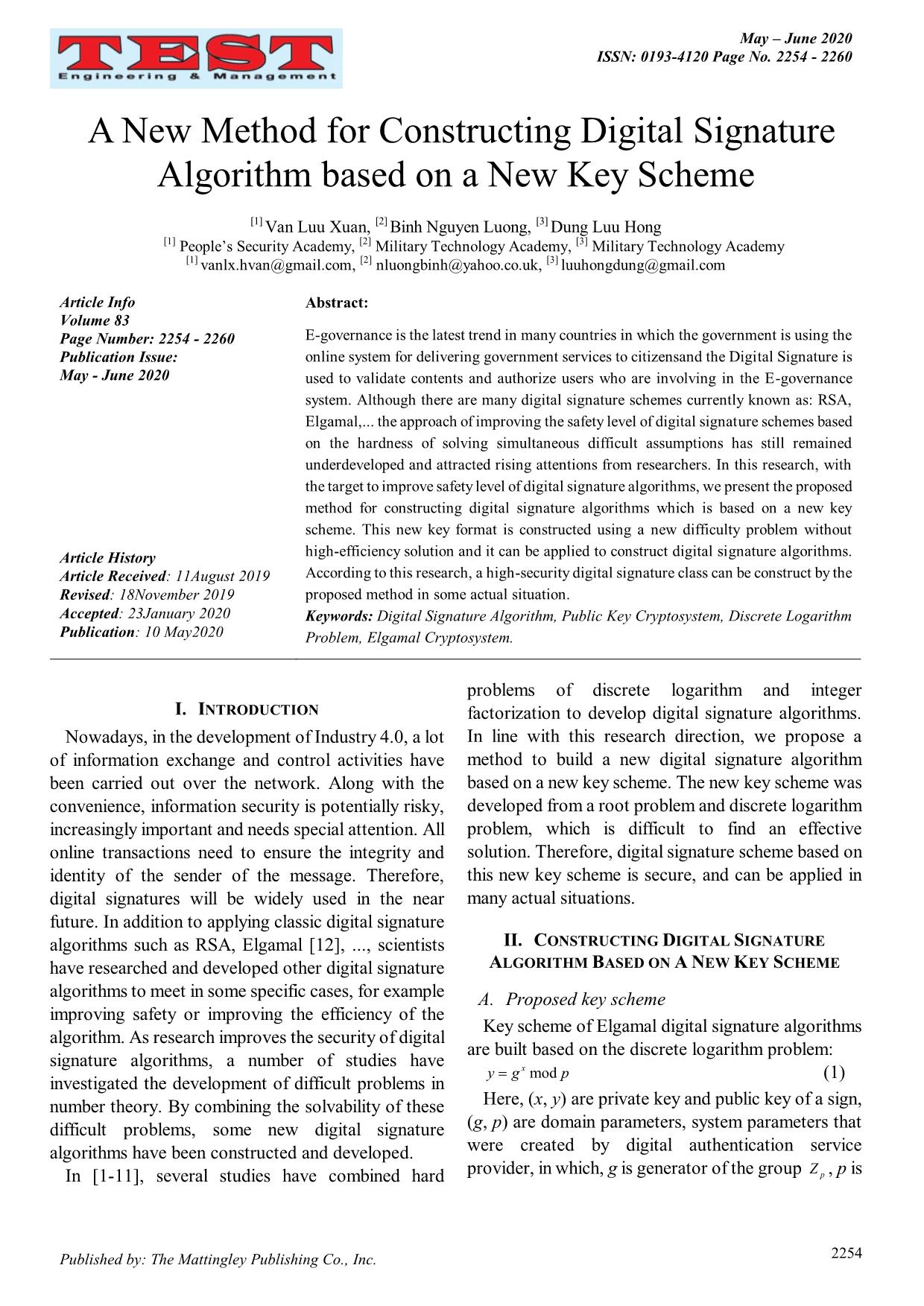
Trang 1
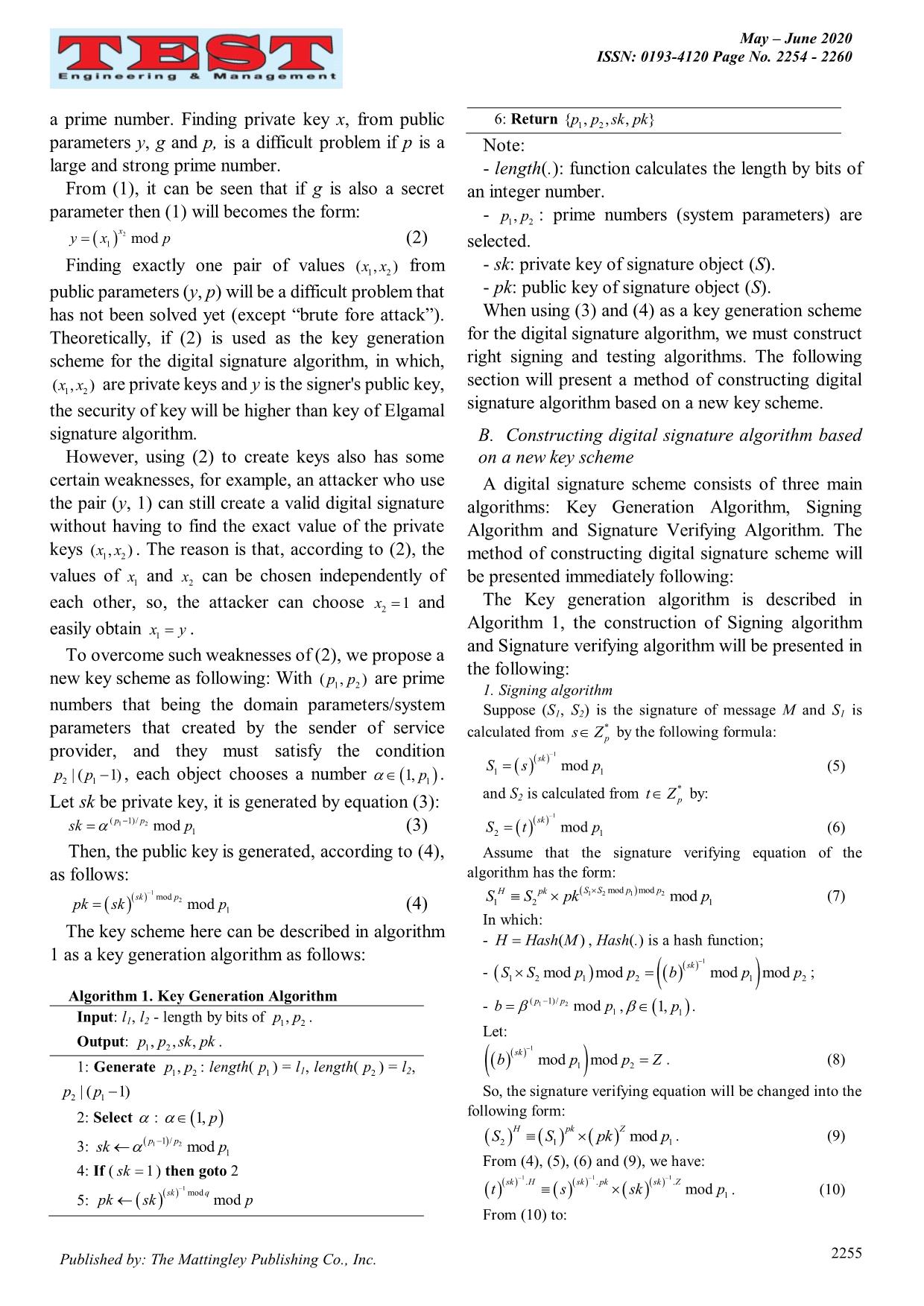
Trang 2
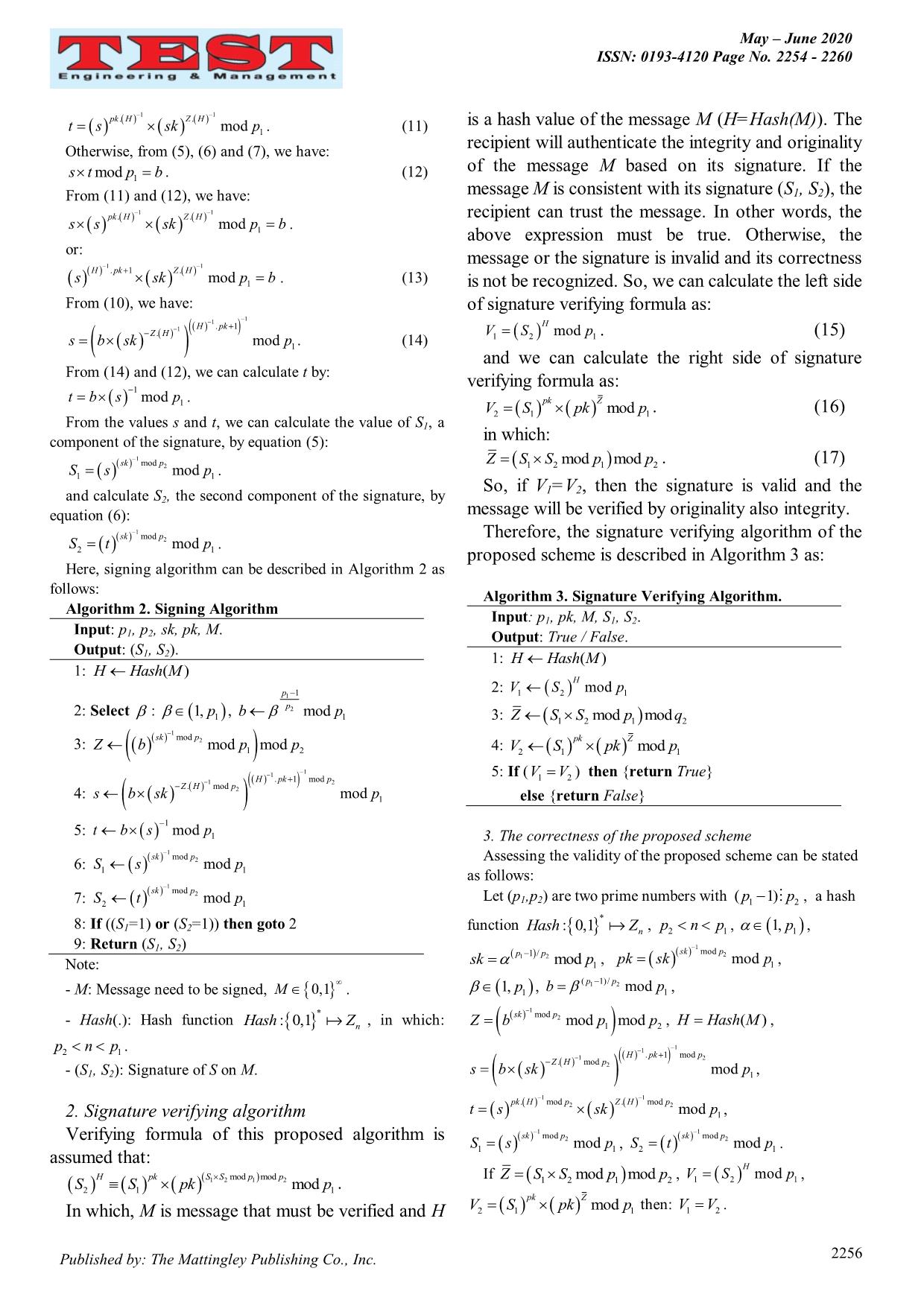
Trang 3
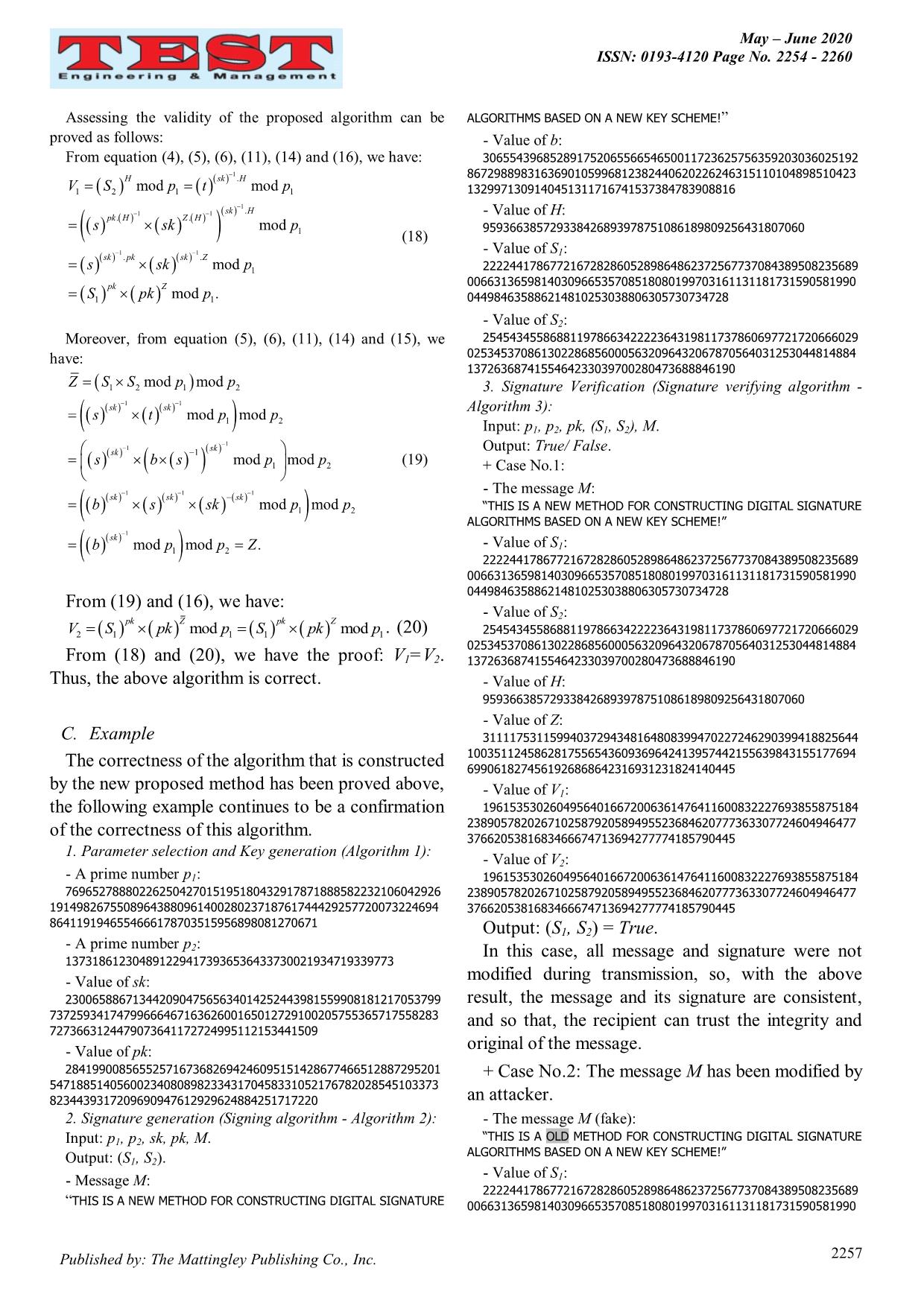
Trang 4
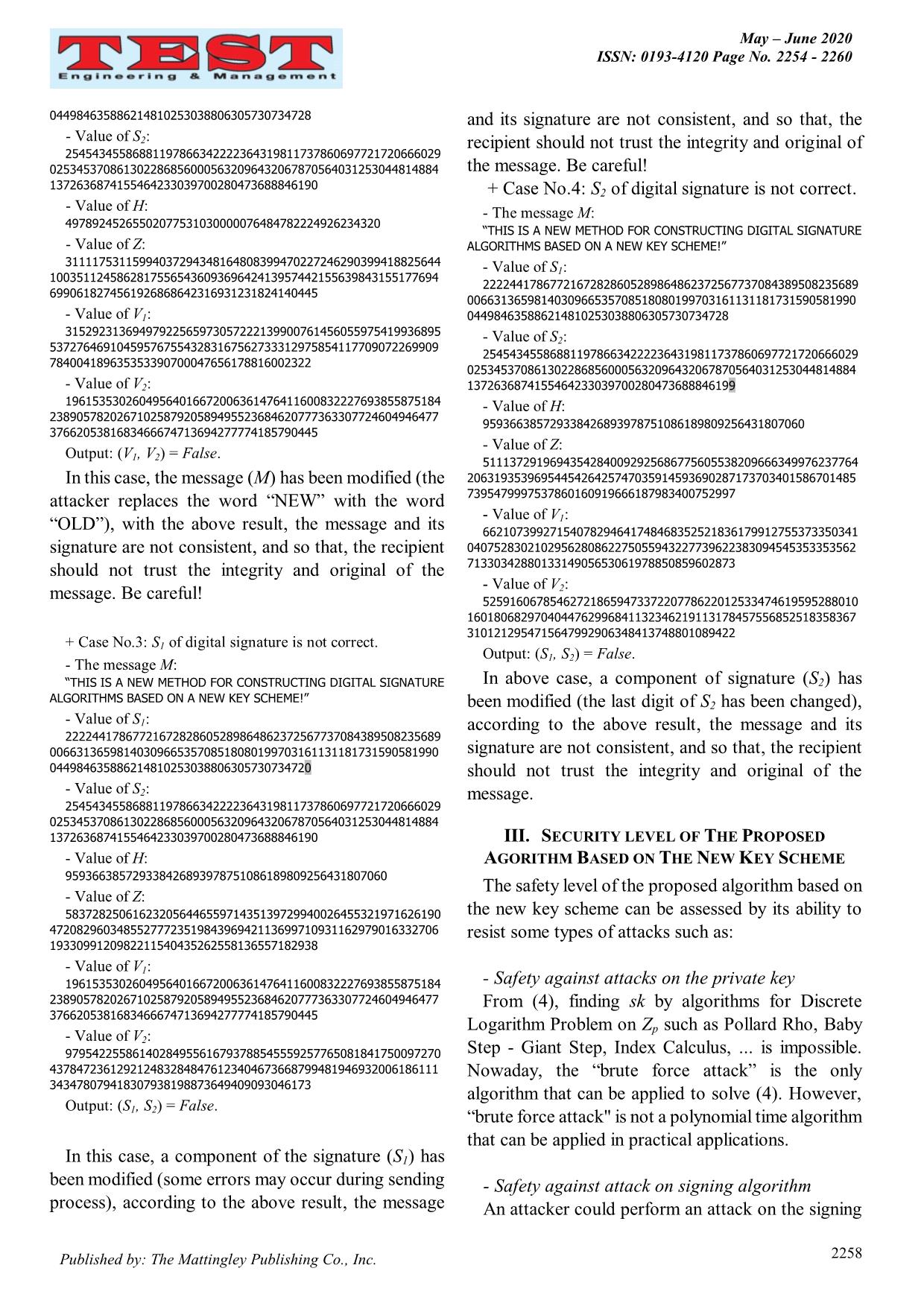
Trang 5
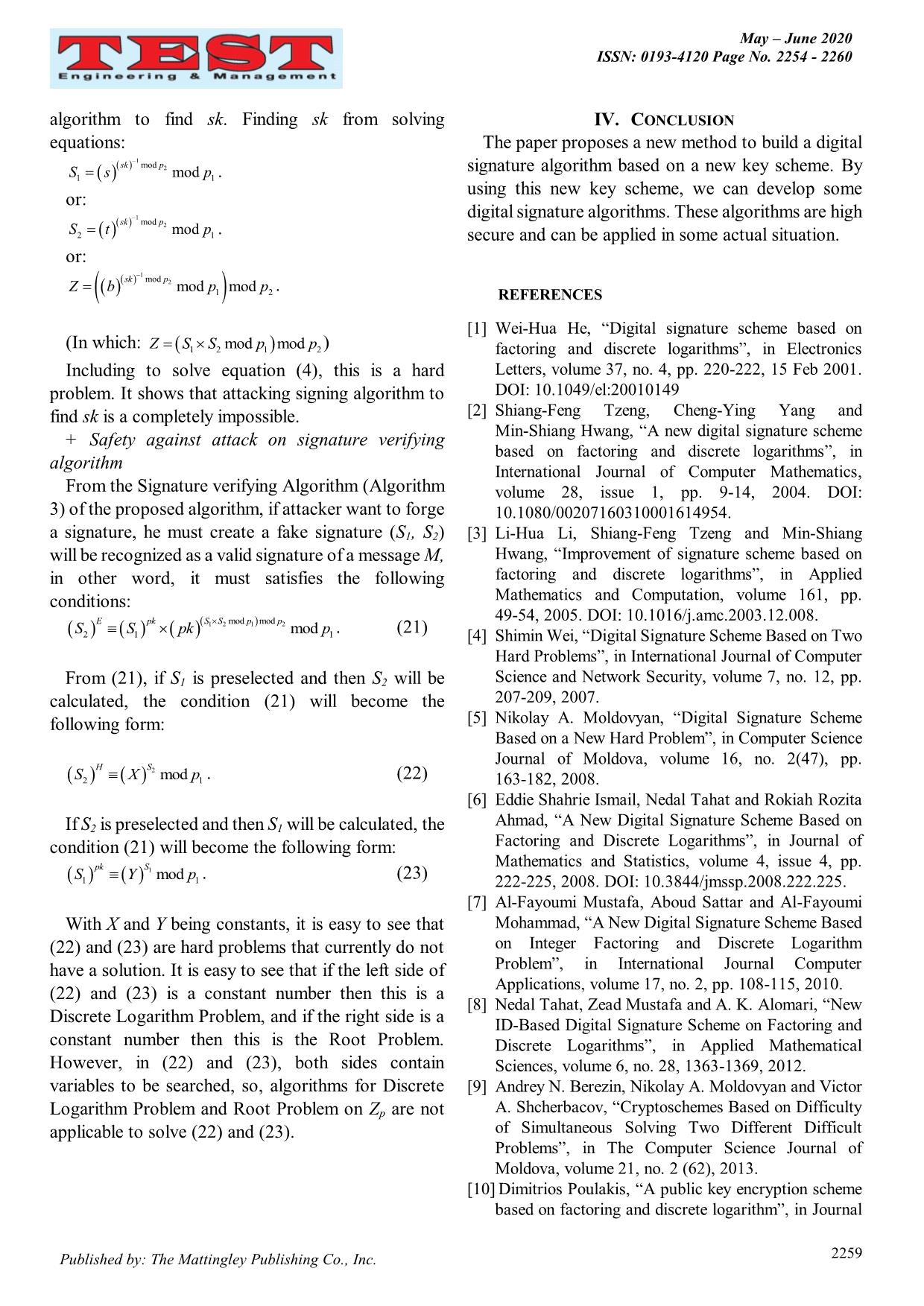
Trang 6
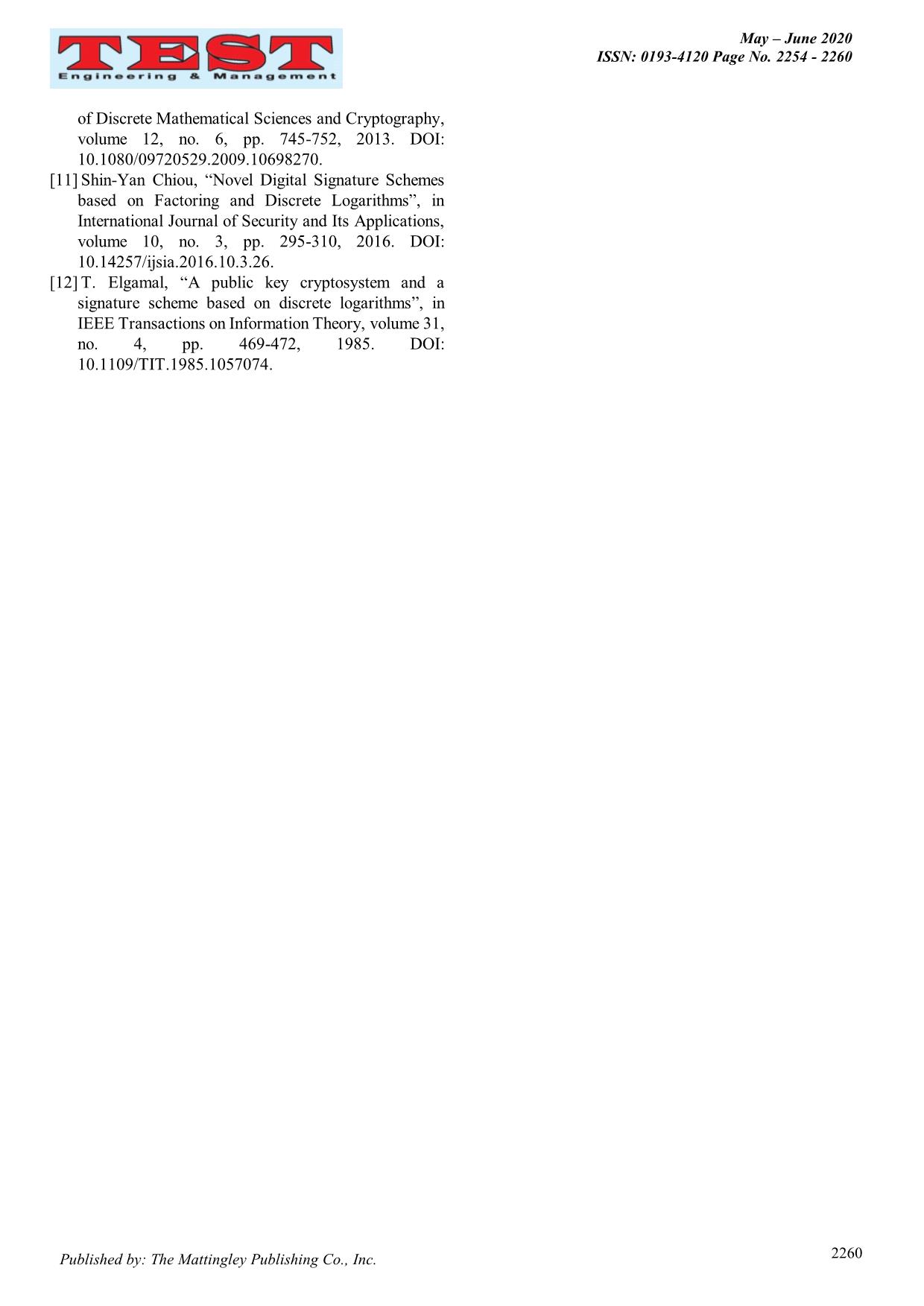
Trang 7
Tóm tắt nội dung tài liệu: A new method for constructing digital signature algorithm based on a new key scheme
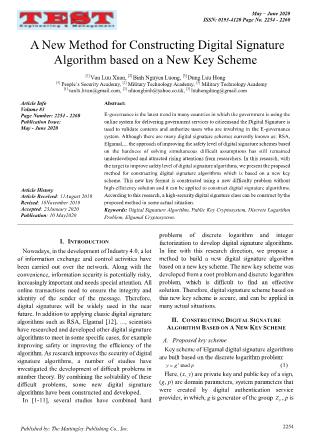
May – June 2020 ISSN: 0193-4120 Page No. 2254 - 2260 2254 Published by: The Mattingley Publishing Co., Inc. A New Method for Constructing Digital Signature Algorithm based on a New Key Scheme [1] Van Luu Xuan, [2] Binh Nguyen Luong, [3] Dung Luu Hong [1] People’s Security Academy, [2] Military Technology Academy, [3] Military Technology Academy [1] vanlx.hvan@gmail.com, [2] nluongbinh@yahoo.co.uk, [3] luuhongdung@gmail.com Article Info Volume 83 Page Number: 2254 - 2260 Publication Issue: May - June 2020 Article History Article Received: 11August 2019 Revised: 18November 2019 Accepted: 23January 2020 Publication: 10 May2020 Abstract: E-governance is the latest trend in many countries in which the government is using the online system for delivering government services to citizensand the Digital Signature is used to validate contents and authorize users who are involving in the E-governance system. Although there are many digital signature schemes currently known as: RSA, Elgamal,... the approach of improving the safety level of digital signature schemes based on the hardness of solving simultaneous difficult assumptions has still remained underdeveloped and attracted rising attentions from researchers. In this research, with the target to improve safety level of digital signature algorithms, we present the proposed method for constructing digital signature algorithms which is based on a new key scheme. This new key format is constructed using a new difficulty problem without high-efficiency solution and it can be applied to construct digital signature algorithms. According to this research, a high-security digital signature class can be construct by the proposed method in some actual situation. Keywords: Digital Signature Algorithm, Public Key Cryptosystem, Discrete Logarithm Problem, Elgamal Cryptosystem. I. INTRODUCTION Nowadays, in the development of Industry 4.0, a lot of information exchange and control activities have been carried out over the network. Along with the convenience, information security is potentially risky, increasingly important and needs special attention. All online transactions need to ensure the integrity and identity of the sender of the message. Therefore, digital signatures will be widely used in the near future. In addition to applying classic digital signature algorithms such as RSA, Elgamal [12], ..., scientists have researched and developed other digital signature algorithms to meet in some specific cases, for example improving safety or improving the efficiency of the algorithm. As research improves the security of digital signature algorithms, a number of studies have investigated the development of difficult problems in number theory. By combining the solvability of these difficult problems, some new digital signature algorithms have been constructed and developed. In [1-11], several studies have combined hard problems of discrete logarithm and integer factorization to develop digital signature algorithms. In line with this research direction, we propose a method to build a new digital signature algorithm based on a new key scheme. The new key scheme was developed from a root problem and discrete logarithm problem, which is difficult to find an effective solution. Therefore, digital signature scheme based on this new key scheme is secure, and can be applied in many actual situations. II. CONSTRUCTING DIGITAL SIGNATURE ALGORITHM BASED ON A NEW KEY SCHEME A. Proposed key scheme Key scheme of Elgamal digital signature algorithms are built based on the discrete logarithm problem: modxy g p (1) Here, (x, y) are private key and public key of a sign, (g, p) are domain parameters, system parameters that were created by digital authentication service provider, in which, g is generator of the group pZ , p is May – June 2020 ISSN: 0193-4120 Page No. 2254 - 2260 2255 Published by: The Mattingley Publishing Co., Inc. a prime number. Finding private key x, from public parameters y, g and p, is a difficult problem if p is a large and strong prime number. From (1), it can be seen that if g is also a secret parameter then (1) will becomes the form: 21 mod x y x p (2) Finding exactly one pair of values 1 2( , )x x from public parameters (y, p) will be a difficult problem that has not been solved yet (except “brute fore attack”). Theoretically, if (2) is used as the key generation scheme for the digital signature algorithm, in which, 1 2( , )x x are private keys and y is the signer's public key, the security of key will be higher than key of Elgamal signature algorithm. However, using (2) to create keys also has some certain weaknesses, for example, an attacker who use the pair (y, 1) can still create a valid digital signature without having to find the exact value of the private keys 1 2( , )x x . The reason is that, according to (2), the values of 1x and 2x can be chosen independently of each other, so, the attacker can choose 2 1x and easily obtain 1x y . To overcome such weaknesses of (2), we propose a new key scheme as following: With 1 2( , )p p are prime numbers that being the domain parameters/system parameters that created by the sender of service provider, and they must satisfy the condition 2 1| ( 1)p p , each object chooses a number 11, p . Let sk be private key, it is generated by equation (3): 1 2( 1)/ 1mod p p sk p (3) Then, the public key is generated, according to (4), as follows: 1 2mod 1mod sk p pk sk p (4) The key scheme here can be described in algorithm 1 as a key generation algorithm as follows: Algorithm 1. Key Generation Algorithm Input: l1, l2 - length by bits of 1 2,p p . Output: 1 2, , ,p p sk pk . 1: Generate 1 2,p p : length( 1p ) = l1, length( 2p ) = l2, 2 1| ( 1)p p ... validity of the proposed algorithm can be proved as follows: From equation (4), (5), (6), (11), (14) and (16), we have: 1 1 1 1 1 1 . 1 2 1 1 . . . 1 . . 1 1 1 mod mod mod mod mod . H sk H sk H pk H Z H sk pk sk Z pk Z V S p t p s sk p s sk p S pk p (18) Moreover, from equation (5), (6), (11), (14) and (15), we have: 1 1 1 1 1 1 1 1 1 2 1 2 1 2 1 1 2 1 2 1 2 mod mod mod mod mod mod mod mod mod mod . sk sk sk sk sk sk sk sk Z S S p p s t p p s b s p p b s sk p p b p p Z (19) From (19) and (16), we have: 2 1 1 1 1mod mod pk Z pk Z V S pk p S pk p . (20) From (18) and (20), we have the proof: V1=V2. Thus, the above algorithm is correct. C. Example The correctness of the algorithm that is constructed by the new proposed method has been proved above, the following example continues to be a confirmation of the correctness of this algorithm. 1. Parameter selection and Key generation (Algorithm 1): - A prime number p1: 76965278880226250427015195180432917871888582232106042926 1914982675508964388096140028023718761744429257720073224694 8641191946554666178703515956898081270671 - A prime number p2: 1373186123048912294173936536433730021934719339773 - Value of sk: 23006588671344209047565634014252443981559908181217053799 7372593417479966646716362600165012729100205755365717558283 7273663124479073641172724995112153441509 - Value of pk: 28419900856552571673682694246095151428677466512887295201 5471885140560023408089823343170458331052176782028545103373 8234439317209690947612929624884251717220 2. Signature generation (Signing algorithm - Algorithm 2): Input: p1, p2, sk, pk, M. Output: (S1, S2). - Message M: “THIS IS A NEW METHOD FOR CONSTRUCTING DIGITAL SIGNATURE ALGORITHMS BASED ON A NEW KEY SCHEME!” - Value of b: 30655439685289175206556654650011723625756359203036025192 8672988983163690105996812382440620226246315110104898510423 1329971309140451311716741537384783908816 - Value of H: 959366385729338426893978751086189809256431807060 - Value of S1: 22224417867721672828605289864862372567737084389508235689 0066313659814030966535708518080199703161131181731590581990 044984635886214810253038806305730734728 - Value of S2: 25454345586881197866342222364319811737860697721720666029 0253453708613022868560005632096432067870564031253044814884 1372636874155464233039700280473688846190 3. Signature Verification (Signature verifying algorithm - Algorithm 3): Input: p1, p2, pk, (S1, S2), M. Output: True/ False. + Case No.1: - The message M: “THIS IS A NEW METHOD FOR CONSTRUCTING DIGITAL SIGNATURE ALGORITHMS BASED ON A NEW KEY SCHEME!” - Value of S1: 22224417867721672828605289864862372567737084389508235689 0066313659814030966535708518080199703161131181731590581990 044984635886214810253038806305730734728 - Value of S2: 25454345586881197866342222364319811737860697721720666029 0253453708613022868560005632096432067870564031253044814884 1372636874155464233039700280473688846190 - Value of H: 959366385729338426893978751086189809256431807060 - Value of Z: 31111753115994037294348164808399470227246290399418825644 1003511245862817556543609369642413957442155639843155177694 6990618274561926868642316931231824140445 - Value of V1: 19615353026049564016672006361476411600832227693855875184 2389057820267102587920589495523684620777363307724604946477 3766205381683466674713694277774185790445 - Value of V2: 19615353026049564016672006361476411600832227693855875184 2389057820267102587920589495523684620777363307724604946477 3766205381683466674713694277774185790445 Output: (S1, S2) = True. In this case, all message and signature were not modified during transmission, so, with the above result, the message and its signature are consistent, and so that, the recipient can trust the integrity and original of the message. + Case No.2: The message M has been modified by an attacker. - The message M (fake): “THIS IS A OLD METHOD FOR CONSTRUCTING DIGITAL SIGNATURE ALGORITHMS BASED ON A NEW KEY SCHEME!” - Value of S1: 22224417867721672828605289864862372567737084389508235689 0066313659814030966535708518080199703161131181731590581990 May – June 2020 ISSN: 0193-4120 Page No. 2254 - 2260 2258 Published by: The Mattingley Publishing Co., Inc. 044984635886214810253038806305730734728 - Value of S2: 25454345586881197866342222364319811737860697721720666029 0253453708613022868560005632096432067870564031253044814884 1372636874155464233039700280473688846190 - Value of H: 49789245265502077531030000076484782224926234320 - Value of Z: 31111753115994037294348164808399470227246290399418825644 1003511245862817556543609369642413957442155639843155177694 6990618274561926868642316931231824140445 - Value of V1: 31529231369497922565973057222139900761456055975419936895 5372764691045957675543283167562733312975854117709072269909 784004189635353390700047656178816002322 - Value of V2: 19615353026049564016672006361476411600832227693855875184 2389057820267102587920589495523684620777363307724604946477 3766205381683466674713694277774185790445 Output: (V1, V2) = False. In this case, the message (M) has been modified (the attacker replaces the word “NEW” with the word “OLD”), with the above result, the message and its signature are not consistent, and so that, the recipient should not trust the integrity and original of the message. Be careful! + Case No.3: S1 of digital signature is not correct. - The message M: “THIS IS A NEW METHOD FOR CONSTRUCTING DIGITAL SIGNATURE ALGORITHMS BASED ON A NEW KEY SCHEME!” - Value of S1: 22224417867721672828605289864862372567737084389508235689 0066313659814030966535708518080199703161131181731590581990 044984635886214810253038806305730734720 - Value of S2: 25454345586881197866342222364319811737860697721720666029 0253453708613022868560005632096432067870564031253044814884 1372636874155464233039700280473688846190 - Value of H: 959366385729338426893978751086189809256431807060 - Value of Z: 58372825061623205644655971435139729940026455321971626190 4720829603485527772351984396942113699710931162979016332706 1933099120982211540435262558136557182938 - Value of V1: 19615353026049564016672006361476411600832227693855875184 2389057820267102587920589495523684620777363307724604946477 3766205381683466674713694277774185790445 - Value of V2: 97954225586140284955616793788545559257765081841750097270 4378472361292124832848476123404673668799481946932006186111 343478079418307938198873649409093046173 Output: (S1, S2) = False. In this case, a component of the signature (S1) has been modified (some errors may occur during sending process), according to the above result, the message and its signature are not consistent, and so that, the recipient should not trust the integrity and original of the message. Be careful! + Case No.4: S2 of digital signature is not correct. - The message M: “THIS IS A NEW METHOD FOR CONSTRUCTING DIGITAL SIGNATURE ALGORITHMS BASED ON A NEW KEY SCHEME!” - Value of S1: 22224417867721672828605289864862372567737084389508235689 0066313659814030966535708518080199703161131181731590581990 044984635886214810253038806305730734728 - Value of S2: 25454345586881197866342222364319811737860697721720666029 0253453708613022868560005632096432067870564031253044814884 1372636874155464233039700280473688846199 - Value of H: 959366385729338426893978751086189809256431807060 - Value of Z: 51113729196943542840092925686775605538209666349976237764 2063193539695445426425747035914593690287173703401586701485 7395479997537860160919666187983400752997 - Value of V1: 66210739927154078294641748468352521836179912755373350341 0407528302102956280862275055943227739622383094545353353562 7133034288013314905653061978850859602873 - Value of V2: 52591606785462721865947337220778622012533474619595288010 1601806829704044762996841132346219113178457556852518358367 3101212954715647992906348413748801089422 Output: (S1, S2) = False. In above case, a component of signature (S2) has been modified (the last digit of S2 has been changed), according to the above result, the message and its signature are not consistent, and so that, the recipient should not trust the integrity and original of the message. III. SECURITY LEVEL OF THE PROPOSED AGORITHM BASED ON THE NEW KEY SCHEME The safety level of the proposed algorithm based on the new key scheme can be assessed by its ability to resist some types of attacks such as: - Safety against attacks on the private key From (4), finding sk by algorithms for Discrete Logarithm Problem on Zp such as Pollard Rho, Baby Step - Giant Step, Index Calculus, ... is impossible. Nowaday, the “brute force attack” is the only algorithm that can be applied to solve (4). However, “brute force attack" is not a polynomial time algorithm that can be applied in practical applications. - Safety against attack on signing algorithm An attacker could perform an attack on the signing May – June 2020 ISSN: 0193-4120 Page No. 2254 - 2260 2259 Published by: The Mattingley Publishing Co., Inc. algorithm to find sk. Finding sk from solving equations: 1 2mod 1 1mod sk p S s p . or: 1 2mod 2 1mod sk p S t p . or: 1 2mod 1 2mod mod sk p Z b p p . (In which: 1 2 1 2mod modZ S S p p ) Including to solve equation (4), this is a hard problem. It shows that attacking signing algorithm to find sk is a completely impossible. + Safety against attack on signature verifying algorithm From the Signature verifying Algorithm (Algorithm 3) of the proposed algorithm, if attacker want to forge a signature, he must create a fake signature (S1, S2) will be recognized as a valid signature of a message M, in other word, it must satisfies the following conditions: 1 2 1 2mod mod 2 1 1mod E pk S S p p S S pk p . (21) From (21), if S1 is preselected and then S2 will be calculated, the condition (21) will become the following form: 22 1mod H S S X p . (22) If S2 is preselected and then S1 will be calculated, the condition (21) will become the following form: 11 1mod pk S S Y p . (23) With X and Y being constants, it is easy to see that (22) and (23) are hard problems that currently do not have a solution. It is easy to see that if the left side of (22) and (23) is a constant number then this is a Discrete Logarithm Problem, and if the right side is a constant number then this is the Root Problem. However, in (22) and (23), both sides contain variables to be searched, so, algorithms for Discrete Logarithm Problem and Root Problem on Zp are not applicable to solve (22) and (23). IV. CONCLUSION The paper proposes a new method to build a digital signature algorithm based on a new key scheme. By using this new key scheme, we can develop some digital signature algorithms. These algorithms are high secure and can be applied in some actual situation. REFERENCES [1] Wei-Hua He, “Digital signature scheme based on factoring and discrete logarithms”, in Electronics Letters, volume 37, no. 4, pp. 220-222, 15 Feb 2001. DOI: 10.1049/el:20010149 [2] Shiang-Feng Tzeng, Cheng-Ying Yang and Min-Shiang Hwang, “A new digital signature scheme based on factoring and discrete logarithms”, in International Journal of Computer Mathematics, volume 28, issue 1, pp. 9-14, 2004. DOI: 10.1080/00207160310001614954. [3] Li-Hua Li, Shiang-Feng Tzeng and Min-Shiang Hwang, “Improvement of signature scheme based on factoring and discrete logarithms”, in Applied Mathematics and Computation, volume 161, pp. 49-54, 2005. DOI: 10.1016/j.amc.2003.12.008. [4] Shimin Wei, “Digital Signature Scheme Based on Two Hard Problems”, in International Journal of Computer Science and Network Security, volume 7, no. 12, pp. 207-209, 2007. [5] Nikolay A. Moldovyan, “Digital Signature Scheme Based on a New Hard Problem”, in Computer Science Journal of Moldova, volume 16, no. 2(47), pp. 163-182, 2008. [6] Eddie Shahrie Ismail, Nedal Tahat and Rokiah Rozita Ahmad, “A New Digital Signature Scheme Based on Factoring and Discrete Logarithms”, in Journal of Mathematics and Statistics, volume 4, issue 4, pp. 222-225, 2008. DOI: 10.3844/jmssp.2008.222.225. [7] Al-Fayoumi Mustafa, Aboud Sattar and Al-Fayoumi Mohammad, “A New Digital Signature Scheme Based on Integer Factoring and Discrete Logarithm Problem”, in International Journal Computer Applications, volume 17, no. 2, pp. 108-115, 2010. [8] Nedal Tahat, Zead Mustafa and A. K. Alomari, “New ID-Based Digital Signature Scheme on Factoring and Discrete Logarithms”, in Applied Mathematical Sciences, volume 6, no. 28, 1363-1369, 2012. [9] Andrey N. Berezin, Nikolay A. Moldovyan and Victor A. Shcherbacov, “Cryptoschemes Based on Difficulty of Simultaneous Solving Two Different Difficult Problems”, in The Computer Science Journal of Moldova, volume 21, no. 2 (62), 2013. [10] Dimitrios Poulakis, “A public key encryption scheme based on factoring and discrete logarithm”, in Journal May – June 2020 ISSN: 0193-4120 Page No. 2254 - 2260 2260 Published by: The Mattingley Publishing Co., Inc. of Discrete Mathematical Sciences and Cryptography, volume 12, no. 6, pp. 745-752, 2013. DOI: 10.1080/09720529.2009.10698270. [11] Shin-Yan Chiou, “Novel Digital Signature Schemes based on Factoring and Discrete Logarithms”, in International Journal of Security and Its Applications, volume 10, no. 3, pp. 295-310, 2016. DOI: 10.14257/ijsia.2016.10.3.26. [12] T. Elgamal, “A public key cryptosystem and a signature scheme based on discrete logarithms”, in IEEE Transactions on Information Theory, volume 31, no. 4, pp. 469-472, 1985. DOI: 10.1109/TIT.1985.1057074.
File đính kèm:
 a_new_method_for_constructing_digital_signature_algorithm_ba.pdf
a_new_method_for_constructing_digital_signature_algorithm_ba.pdf

